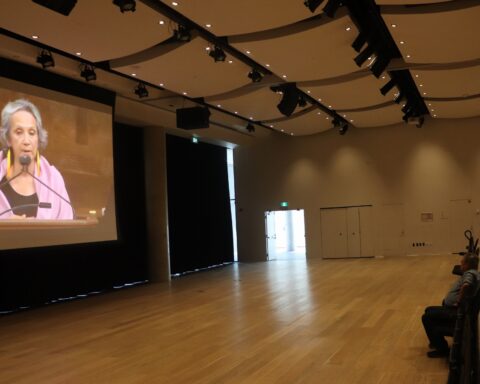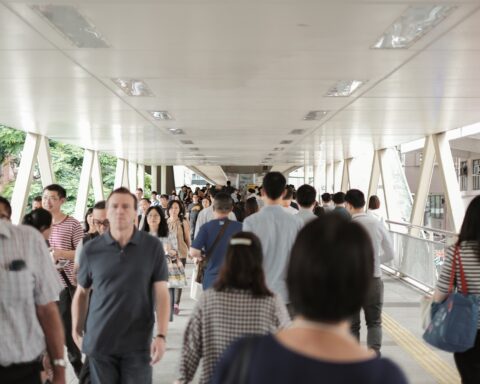Hongkongers have largely stopped applying for Canadian work and study permits under a policy for those fleeing the Beijing-imposed national security law, previously unpublished data from Immigration Refugee and Citizenship Canada (IRCC) shows.
Thousands of people from Hong Kong fled to Canada after China cracked down on dissent and free speech in the former British colony by imposing the national security law in 2020. Since then, many pro-democracy activists have been silenced, civil society groups have been shut down and outspoken media outlets have been closed.
However, a tough job market for new immigrants, housing challenges, competition from the UK and Taiwan, as well as a downturn in the Hong Kong economy could all be behind the sudden slowdown in asylum applications to Canada, according to expert opinion.
The number of Hongkongers who applied and were approved to come to Canada using the policy has never been published before and was supplied exclusively to New Canadian Media by the IRCC.
Just 455 applications were made through the policy in 2023, compared to 16,195 in 2022, and 10,403 in 2021 when the program was first launched, according to figures provided by IRCC.
There was a steep drop off in Hong Kong asylum-seekers choosing Canada in January 2023, when 103 applications were made through the pathway, compared with 1,181 in the month prior.
The program saw its highest number of applicants in November 2022 when 2,222 people submitted paperwork, and Hong Kongers had begun to show disinterest by December of that year.

In both September and November of 2023, only one person applied for a Canadian visa through the program.
Hong Kong has a population of 7.5 million, according to the city’s Census and Statistics Department.
IRCC said Canada has approved 23,684 visas for Hongkongers under the pathway, with 2,535 approved in 2023, compared to 13,383 in 2022, and 7,766 in 2021.
Applications from previous years were processed in 2023, accounting for a greater number of approvals than applications that year.
Slightly more than 90 per cent of applications have been approved under the pathway, IRCC data indicates.
Why the decline?
There are multiple factors that could have caused applications to plummet, according to Miu Chong Yan, a professor of social work at the University of British Columbia who studies immigrant and refugee patterns.
Difficulty finding high-quality work, affordable housing, and accessing health care are common complaints from Hong Kongers who’ve arrived in Canada, Yan found in his research.
Some asylum seekers may have returned to Hong Kong and told others about the difficulties of life in Canada, said Yan, who has interviewed dozens of new arrivals.
Additionally, Hongkongers may have adapted to more restricted freedom of speech following the implementation of the Chinese national security law in 2020, Yan suggested.
The law criminalizes “secession, subversion, terrorism and collusion with foreign forces”, which the IRCC says has been used to shut down dissent.
The UK’s British National Overseas program for Hongkongers with historic ties to Britain could have eaten into the demand for Canada’s policy, Yan added.
“Whether people are now used to what happened in Hong Kong, or they have other choices, we don’t really know,” Yan said.
Advocacy group Saskatchewan Stands with Hong Kong said in an email that saturation of demand for the program and relocation to Taiwan may have slowed applications to Canada.
Slower processing times could have also put a dent in people relocating, both Yan and Saskatchewan Stands with Hong Kong agreed.
Visas were previously getting processed in three months, and are now more likely to take six months, Yan explained.
Financial Barriers
Although the number of people from Hong Kong seeking asylum in Canada has dropped, pressures on the population continue to grow.
The economic might of Hong Kong has declined significantly since 2020, Yan pointed out, which may have contributed to fewer Hongkongers being able to afford a move to Canada.
In addition, foreign companies, excluding those based in China, have moved 143 regional headquarters out of Hong Kong since 2020, according to the city’s Census and Statistics Department.
During that same period, just nine Chinese companies have moved their regional headquarters to Hong Kong.
Most native Hongkongers speak Cantonese, making them easily distinguishable from the Mandarin-speaking people of mainland China.
Cantonese speakers are increasingly facing challenges at work in Hong Kong, Yan confirmed.
“Native Hong Kong people will have a hard time getting promoted,” Yan said.
Universities in the city are replacing Cantonese professors with Mandarin-speaking or foreign faculty, added Yan.
Adding to the financial stress, Hong Kong’s residential property price index has declined year-over-year for 22 straight months, according to Global Property Guide and the city’s Rating and Valuation Department.
If Hong Kongers can’t sell their homes for a profit, they may be less capable of relocating to Canada, Yan explained.
Permanent Residency
Officially called the Public Policy to Support Hong Kong Residents to Come to Canada, the program has a myriad of eligibility requirements, including language skills testing, and intentions to live outside Quebec.
Applicants can choose to either get work or study permits, and the policy ends on August 31, 2026.
Work permit holders can apply for permanent residency after being employed for one year in Canada or after having worked 1,560 hours.
Study permit holders can apply for permanent residency after graduating from a minimum two-year diploma or degree program in Canada.
Among work permit holders, 2,503 have become permanent residents since 2021, while 4,241 student visa holders have been approved for permanent residency, according to IRCC data.
That means 28 per cent of accepted applicants have become permanent residents so far.
Both Yan and Saskatchewan Stands with Hong Kong said Hongkongers need more support from the government after arriving in Canada.
“Hongkongers who arrive in Canada through the pathway often face various issues, including isolation from family members who remain in Hong Kong, targeting and surveillance by the Chinese government due to their activism or political affiliations,” Saskatchewan Stands with Hong Kong said in an email.
William Koblensky Varela is a journalist who reports on local news, finance, and politics. He has worked for Metroland Media, BNN Bloomberg, and Carbon Pulse among others.






Hi, thanks for the article, but I think it might well be an issue of arithmetics.
You see, as the “lifeboat” Stream A + B was only announced by the end of November 2020, meaning the first batch of Stream A + Stream B who were able to apply in 2021 to 2022 must be “upgrades” from other pathways like they were already working in Canada via SOWP (spouse open work permit) — spouses of students “already studying” in Canada -> Stream B, and the students themselves -> Stream A.
As for those who truly come to Canada solely for the purpose, one must realize that, unlike the BN(O) 5+1 in UK where you are in the pathway “immediately” when you land, Stream A actually requires you to finish a 2-year diploma course “first” and then you may apply a Stream A status, while for Stream B, you first have to work with OWP (Open work permit) for “at least” 12 months and attain an accumulated 1560 hours to be eligible, which usually take longer than that if you have been fired or switched jobs.
In short, the high application figures for the first two years were expected, as they were from “existing students” (Stream A eligible) and their spouses (stream B eligible) when the pathway was first announced. The null in 2023 may not mean anything = as the “lifeboat” Stream A + B was only announced by the end of November 2020, meaning that the first batch of “new” comers will only arrive as students by September 2021, finishing their studies and have their graduation certificates just last month or so.
The true picture might finally reveal itself this year, so let’s take a deep breath, and then wait and see.
Interesting. And people still wonder if the CCP has any influence on Chinese-Canadians
Did not address the elephant in the room, which manifested in a court case against a RPD member.